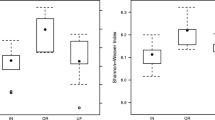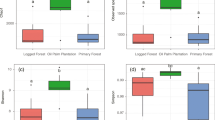Abstract
Background, Aims and Scope
Soil microbial community diversity has been suggested as a way of assessing the ‘health’ or ‘quality’ of soils. While molecular (genetic) or biochemical (phenotypic) measurements of microbial diversity have their place, functional diversity is popular in that it relates to the activity of the soil microflora, particularly in the carbon cycle. Community Level Physiological Profiles (CLPPs) are usually assessed by carbon substrate utilization. The aim here is to review the various methods available for CLPP assessment.
Main Features
The original method for CLPP determination was based upon the Biolog plate with its range of 95 carbon substrates and many studies have been employing this over the past 15 years. However, a number of criticisms have been leveled at the method, principally that it relies upon the growth of an extracted microbial population, which may not represent the true functioning of the whole soil. A multiple carbon-source, substrate induced respiration method (multi-SIR) was developed that did measure the response of the whole soil community without the need for growth but it did not have the convenience of the microtitre plate format. MicroResp™ was designed to overcome the deficiencies in both methods and we have applied it to a range of media including mineral and organic soils, sediments and litter. In addition we have adapted the method to the testing of a wide range of carbon substrates such as hydrocarbons, terpenes and pesticides.
Results
The MicroResp™ technique covers the middle road of relevance and convenience, being a ‘whole soil’ method in a flexible microtitre plate format. It also has the advantage that it can be adapted for the use of radiolabelled (14C) substrates, which increases the specificity and sensitivity of the assay. A few direct comparisons between MicroResp™ have been made. We have found that its discriminatory ability compares favourably with Biolog while other users have reported it to be superior to the multiple SIR approach. A number of laboratories around the world are now utilizing MicroResp™ and reporting good sensitivity to changes to the microbial community due to such varied factors as age of forest rehabilitation, heavy metal treatment, hydrocarbon exposure, salinity, peatland vegetation, cropping system and tree clone type.
Discussion
A comparison of the available methods reveals that each has its advantages and drawbacks. The choice of method may depend upon the particular hypotheses or questions.
Conclusions
MicroResp™ offers a convenient, rapid and sensitive method for the determination of Community Level Physiological Profiles. Its application in a number of case studies has demonstrated its utility and advantages over other methods though its full potential for characterizing soil activity is yet to be realized.
Perspectives
Increasing awareness of the environmental pressures on soils and the need to monitor soil health has resulted in a range of potential indicators. Microbial functional diversity is one such indicator that seeks to characterize a core soil attribute. The availability of rapid methods for its assessment will aid our understanding of such pressures on basic soil functioning.
Similar content being viewed by others
References
Artz RRE, Chapman SJ, Campbell CD (2006): Substrate utilization profiles of microbial communities in peat are depth dependent and correlate with whole soil FTIR profiles. Soil Biol Biochem 38, 2958–2962
Campbell CD, Chapman SJ, Cameron CM, Davidson MS, Potts JM (2003): A rapid microtiter plate method to measure carbon dioxide evolved from carbon substrate amendments so as to determine the physiological profiles of soil microbial communities by using whole soil. Appl Environ Microbiol 69, 3593–3599
Campbell CD, Grayston SJ, Hirst DJ (1997): Use of rhizosphere carbon sources in sole carbon source tests to discriminate soil microbial communities. J Microbiol Meth 30, 33–41
Cook KL, Garland JL, Layton AC, Dionisi HM, Levine LH, Sayler GS (2006): Effect of microbial species richness on community stability and community function in a model plant-based wastewater processing system. Microbial Ecol 52, 725–737
Degens BP, Harris JA (1997): Development of a physiological approach to measuring the catabolic diversity of soil microbial communities. Soil Biol Biochem 29, 1309–1320
Degens BP, Schipper LA, Sparling GP, Duncan LC (2001): Is the microbial community in a soil with reduced catabolic diversity less resistant to stress or disturbance? Soil Biol Biochem 33, 1143–1153
Dobranic JK, Zak JC (1999): A microtiter plate procedure for evaluating fungal functional diversity. Mycologia 91, 756–765
Garland JL, Campbell CD, Mills AL (2007): Physiological profiling of microbial communities. In: Hurst CJ, Crawford RL, Garland JL, Lipson DA, Mills AL, Stetzenbach LD (eds), Manual of Environmental Microbiology, 3rd Edition. ASM Press
Garland JL, Mills AL (1991): Classification and characterization of heterotrophic microbial communities on the basis of patterns of community-level sole-carbon-source utilization. Appl Environ Microbiol 57, 2351–2359
Garland JL, Roberts MS, Levine LH, Mills AL (2003): Community-level physiological profiling performed with an oxygen-sensitive fluorophore in a microtiter plate. Appl Environ Microbiol 69, 2994–2998
Ginzburg O, Steinberger Y (2006): The effect of harvester ant (Messor spp.) nest activity on soil microbial biomass and functional diversity in a desert system. The 34th Annual Israel Society for Ecology and Environmental Quality Sciences Conference, Haifa, Israel, 26–27 June 2006
Gupta V (2006): Soil Biodiversity Monitoring. 48–55. 2006. Mallee Sustainable Farming, Mallee Grain & Graze Project Results May 2006. 〈http://www.grainandgraze.com.au/library/scripts/objectifyMedia.aspx?file=pdf/87/21.pdf&siteID=11&str_title=Soil%20biodiversity%20results%202005.pdf〉
Insam H (1997): A new set of substrates proposed for community characterization in environmental samples. In: Insam H, Rangger A (eds), Microbial Communities. Springer, Berlin, pp 259–260
Kaufmann K, Chapman SJ, Campbell CD, Harms H, Höhener P (2006): Miniaturized test system for soil respiration induced by volatile pollutants. Environ Pollut 140, 269–278
Lagomarsino A, De Angelis P, Moscatelli MC, Insam H, Grego S (2006): The role of rhizosphere on soil microbial processes under elevated atmosphericCO2: An experimental approach on poplar trees. Geophysical Research Abstracts 8, 08197. 〈http://www.cosis.net/abstracts/EGU06/08197/EGU06-J-08197.pdf〉
Lagomarsino A, Knapp B, Moscatelli MC, De Angelis P, Grego S, Insam H (2007): Structural and functional diversity of soil microbes is affected by elevated [CO2] and N addition in a poplar plantation. J Soils Sediments 7(6) 399–405
Lalor BM, Cookson WR, Murphy DV (2007): Comparison of two methods that assess soil community level physiological profiles in a forest ecosystem. Soil Biol Biochem 39, 454–462
Licona Manzur CG (2002): A combined chemical and biological approach to the measurement of chromium speciation, availability & ecotoxicity in contaminated soils. Ph.D. Thesis, University of Edinburgh
Loisel P, Harmand J, Zemb O, Latrille E, Lobry C, Delgenes JP, Godon JJ (2006): Denaturing gradient electrophoresis (DGE) and single-strand conformation polymorphism (SSCP) molecular fingerprintings revisited by simulation and used as a tool to measure microbial diversity. Environmental Microbiology 8, 720–731
Preston-Mafham J, Boddy L, Randerson PF (2002): Analysis of microbial community functional diversity using sole-carbon-source utilisation profiles — A critique. FEMS Microbiol Ecol 42, 1–14
Rubatscher D, Wohlmuth R, Insam H, Bahn M (2006): Is litter decomposition affected by plant and microbial functional diversity and land use? Open Science Conference on the GHG Cycle in the Northern Hemisphere, Sissi-Lassithi, Crete, 14–18 November 2006. 〈www.bgc-jena.mpg.de/bgc-processes/ceip/conference/files/Conference_Proceedings_SO_poster.pdf〉
Smalla K, Wachtendorf U, Heuer H, Liu WT, Forney L (1998): Analysis of BIOLOG GN substrate utilization patterns by microbial communities. Applied and Environmental Microbiology 64, 1220–1225
Stefanowicz A (2006): The Biolog plates technique as a tool in ecological studies of microbial communities. Polish Journal of Environmental Studies 15, 669–676
West AW, Sparling GP (1986): Modifications to the substrate-induced respiration method to permit measurement of microbial biomass in soils of differing water contents. J Microbiol Meth 5, 177–189
White DC, MacNaughton SJ (1997): Chemical and molecular approaches for rapid assessment of the biological status of soils. In: Pankhurst CE, Doube BM, Gupta VVSR (eds), Biological Indicators of Soil Health. CAB International, pp 371–396
Author information
Authors and Affiliations
Corresponding author
Additional information
ESS-Submission Editor: Jizheng (Jim) He, PhD (jzhe@rcees.ac.cn)
Rights and permissions
About this article
Cite this article
Chapman, S.J., Campbell, C.D. & Artz, R.R.E. Assessing CLPPs using MicroResp™. J Soils Sediments 7, 406–410 (2007). https://doi.org/10.1065/jss2007.10.259
Received:
Accepted:
Published:
Issue Date:
DOI: https://doi.org/10.1065/jss2007.10.259




